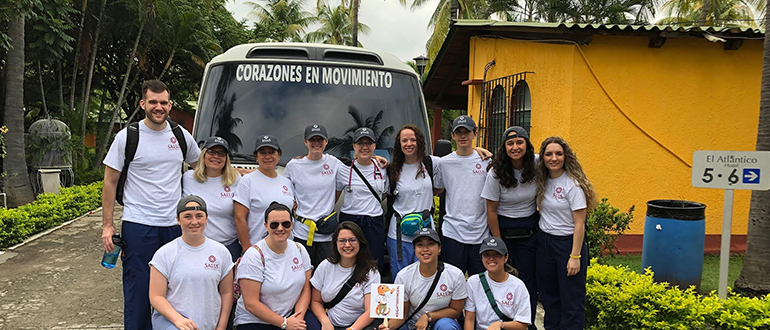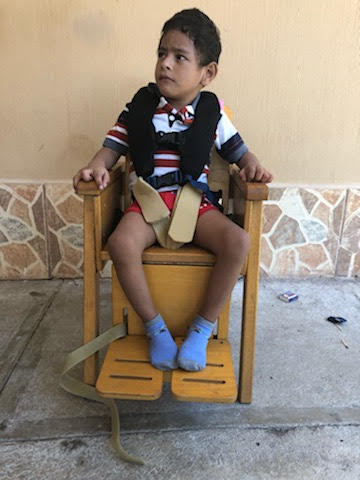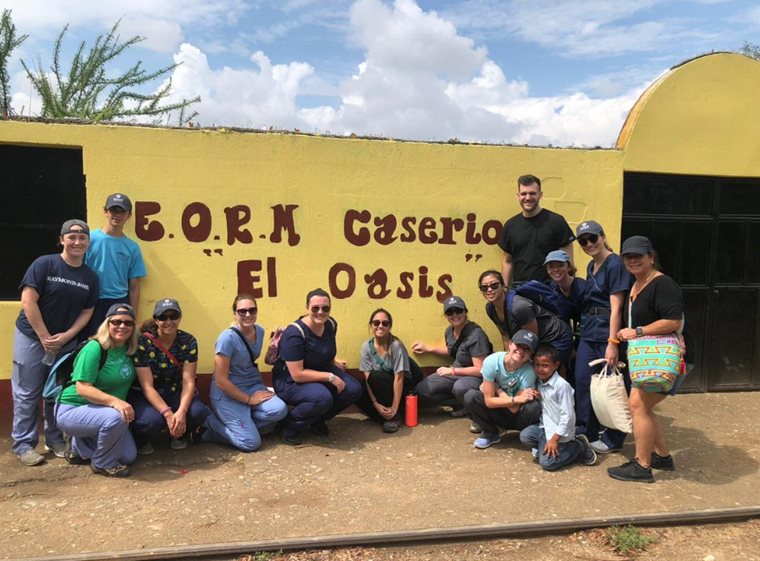
On the first clinic day of a mission trip to Guatemala, students met a child with cerebral palsy who had never been able to sit up. The boy had been going to physical therapy since birth, but he had not acquired the strength enough to hold himself in a seated position.
“His family had always had him lying on his belly and he lived his life like that,” said Jeanne-Marie Pennington, MSPAS, PA-C, clinical coordinator and assistant professor in the Physician Assistant (PA) Studies program at Salus, who led a group of seven PA students and two Masters of Occupational Therapy (OT) students on a weeklong mission trip to Zacapa, Guatemala, Aug. 17-24. “They talked to him, they interacted with him, but he was never off of his belly, or he would roll over onto his back. But not on his own, he didn’t have the strength to do that,” she said.
On the third day of the trip, Salus OT students Madeleine Stucky ’20OT, and Ashley Kinton, ’20OT, along with their OT mentor Luisa Rodriguez, OTR/L, spent the day at the physical therapy (PT) clinic in the area run by Hearts in Motion (HIM), with whom the Salus group was working. Hearts in Motion provides quality healthcare and assists in the development of social programs to improve health, education and welfare for people in the U.S. and Central and South America.
 The boy with cerebral palsy was brought to the Hearts in Motion PT clinic, where the Salus OT students, along with the HIM physical therapist, tried to come up with a solution. They found an old chair in a storage area, cleaned it up and adapted it for the boy, so he could be strapped into it sitting up.
The boy with cerebral palsy was brought to the Hearts in Motion PT clinic, where the Salus OT students, along with the HIM physical therapist, tried to come up with a solution. They found an old chair in a storage area, cleaned it up and adapted it for the boy, so he could be strapped into it sitting up.
“For the first time in his life, he was able to sit up. It was an amazing thing. His family was so delighted to be able to look at him in the face sitting up when they were talking to him,” said Pennington.
It was one of several highlights for the Salus contingent on the University’s first trip of this kind to Guatemala, after having served patients in Panama on past trips. And, what the students found were many stark reminders of the healthcare challenges facing the Guatemalan people in that area of the country.
“If somebody gets sick, they just wait until they get better, more often than not,” said Pennington. “They don’t have enough money to eat three times a day, let alone go to the hospital. Oftentimes they’re making the decision to feed their kids versus taking their medicine.”
The students were evaluating and treating about 80 patients a day for five days on the medical volunteer trip, which was designed to bring healthcare to people who don’t have access to it. They travelled to five different communities to conduct the clinics where they conducted general examinations, gathered patient histories and conducted physicals.
“I thought the students did an amazing job. These are upcoming second-year students, so they just finished their didactic curriculum. They’re getting ready to go out into the clinical environment for a year,” said Pennington. “So, this is their first exposure to true patient contact.”
 On the second day of the trip, the group took sandwiches and drinks to families – between 300 and 400 people – who lived in an actual dump. That left a lasting impression on many of the students.
On the second day of the trip, the group took sandwiches and drinks to families – between 300 and 400 people – who lived in an actual dump. That left a lasting impression on many of the students.
“When you are in a country with limited resources, you have to work with what you have,” said Viviana Di Stefano, ’20PA, who speaks Spanish and was able to see patients without the help of a translator. “We went to different cities and helped different populations of patients. The dump was the hardest for me. They walked us through the landfill to get us exposed to their living conditions. As a parent, it was truly heartbreaking to see children my son’s age playing in the landfill with plastic on the floor to clean their muddy feet using plastic shards from the ground to scrape the mud from their bodies”
Elliot Dutton, ’20PA, called the trip an “incredible experience.”
“Guatemala was filled with poverty and people were living in conditions that I could not imagine,” he said. “It taught me the importance of community and how it can help people overcome these conditions.”
Dutton cited the guidance of Pennington, along with his hardworking and flexible classmates, that taught him about treating patients with limited resources.
“It helped me learn a lot by being put in uncomfortable situations. I was nervous going into my first rotation, but I keep reminding myself that it won’t be too bad after my experience in Guatemala,” he said.
Di Stefano agreed that not all lessons learned are limited to the classroom or the clinics. Sometimes on a trip like this, one learns about oneself, she said.
 "While I was there, I realized that I was able to cut out all the unnecessary concerns and just focus on the patient,” she said. “I went with my gut instinct and that did not fail me. These patients have faced so much adversity and we have so much to learn from them.”
"While I was there, I realized that I was able to cut out all the unnecessary concerns and just focus on the patient,” she said. “I went with my gut instinct and that did not fail me. These patients have faced so much adversity and we have so much to learn from them.”
In addition to PA students Di Stefano and Dutton, OT students Stucky and Kinton, other students included Marina Brown, ’20PA, Iva Hodaj, ’20PA, Andrea Hensley, ’20PA, Nikki Harnwell, ’20PA and Amanda Ocampo, ’20PA in addition to four volunteers, Luisa Rodriguez, OTR/L from Shriners Hospital, Kristine Du, a friend of one of the students, and Pennington’s children, Brianna and Ethan.
Pennington was impressed with how the students progressed through the course of the trip.
“From Day One – where their eyes were huge – to Day Five, they were like ‘We got this.’ We can teach it to some degree, but the experience they’re getting, there’s no way to compare it,” said Pennington. “Even our student experiences here in the lab, where the facilitator is one-on-one with a student, doesn’t mean anything until that patient is sitting in front of you. Then you have to give them a diagnosis, or tell them there’s nothing you can do for their problem. That’s one of the hardest things to do to somebody living in a community where there is no access to healthcare.”